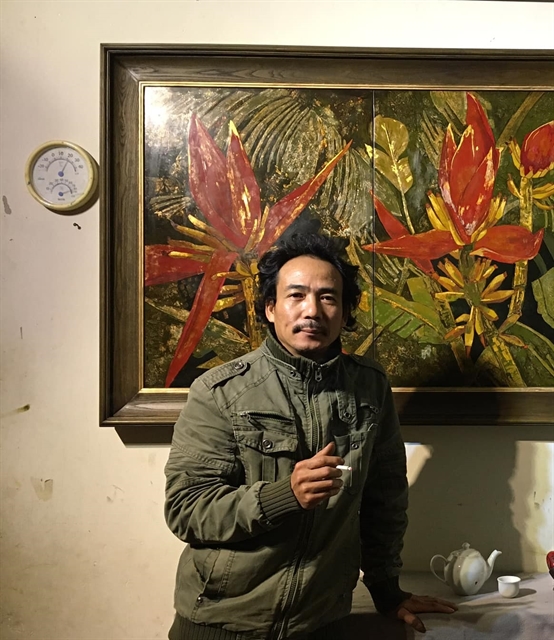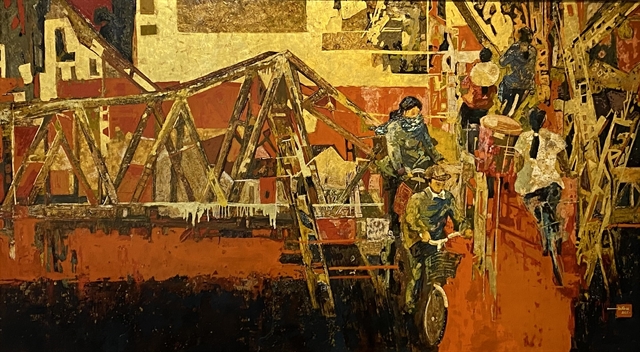 Life & Style
Life & Style

Việt Nam News reporter Nguyễn Bình chats with Đỗ Khải about his career.

|
| Artist Đỗ Khải |
Artist Đỗ Khải is one of five original Vietnamese Lacquer Artists group members, which aims to preserve and develop traditional lacquer. He insists on working with traditional lacquer material made from the purified sap of the lacquer tree in the northern province of Phú Thọ.
He is currently showing his latest paintings in a group exhibition in Hà Nội.
Việt Nam News reporter Nguyễn Bình chats with Khải about his career.
How many works did you display in the recent exhibition?
The exhibition entitled Ngẫu Hứng (Improvisation) shows the works of my three friends, including Hải Phòng-based artist Việt Anh, sculptor Lê Khuy, artist Nguyễn Thuật and me.
It introduces silk and lacquer paintings and ceramic sculptures.
I have 16 paintings that I have made in recent years. I want to show viewers the richness and diversification of my compositions which are not limited to a topic or way of expression.
I introduce paintings with a realistic style featuring the northern rural landscapes with a bit of nostalgia about rural areas. Moreover, I still keep painting Long Biên Bridge which I gained success with ten years ago.
The old Long Biên Bridge always inspires me. It is over 100 years old to symbolise Hà Nội in the subsidy period, with images of painstaking women riding bicycles to earn a living.
I also debuted some other works with abstract expressionism.

|
| One of the new paintings of Long Biên Bridge by Đỗ Khải. |
Does the abstract expressionism of art suit lacquer paintings?
In composing paintings I have researched and presented works with different styles at each stage. Sometimes, the work's content or idea determines how it is expressed.
I experimented the abstract expressionism art a few years ago. Then I try different art styles. But no matter how different and what art style I draw, my colleagues still see me in the paintings.
How did you become an artist?
I used to be a teacher at a primary school. It is a chance for me to become an artist. It is a long story to take the opportunity. I entered the Việt Nam University of Fine Arts when I was 37. After graduating from the painting department, I worked in the Việt Nam Fine Arts Association's office for a while.
Then I quit the job at the association focusing on painting. Some people think that this is not a good choice. But I never regretted my decision. It is not a smooth road for me to be recognised in the circle, but I'm happy to create art living with my passion for painting.
Could you tell me about your field trip to Japan under the Asian Lacquer Exchange and Research Project at the Tokyo University of the Arts?
Three Vietnamese artists and I visited the university in October. The project was launched by a Japanese partner ten years ago.
The project aims to preserve, maintain and promote the development and honour of the lacquer art of Asian countries in the face of new challenges when industrialisation tends to drown out the tradition and handicraft values.
While participating artists from Myanmar, Thailand, Laos and Cambodia brought very diverse and national cultural identities, Vietnamese artists displayed lacquer paintings. Vietnamese lacquer paintings are unique.
We also visited lacquer tree-growing areas in Japan and met Japanese artisans.
We made good use of the trip to popular the value of Vietnamese lacquer painting and made international colleagues know more about it, gaining high recognition.
You had a chance to join in an award-winning documentary entitled Walking through the valley of death by Vietnam News Agency. Why were you a part of the movie crew?
This is the first time I have illustrated for a film. I think it is special and its name is also special. I was obsessed with the characters in the document. They are heroes, and they inspire me.
Along with the initial suggestion of the crew, I immediately formed an idea to show the illustration to suit the film's content. I worked with the crew while I was very busy moving my workshop and preparing for the Japan field trip and the group exhibition.
The documentary winning the international awards was a nice surprise for me. I'm moved because I have made a small contribution to the documentary.
The most important thing is that the film spreads and conveys extremely deep messages that bring human values to everyone. — VNS




